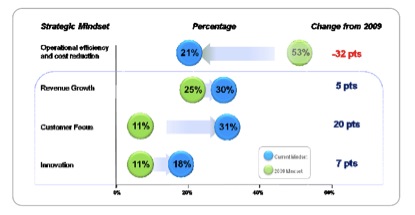“Why are some organizations consistently good at innovating and adapting while others seem to be blindsided by change? Is it because of their disciplined innovation process or the knowledge and skills of their people? Or is it their determination to build a culture where challenging assumptions is not only encouraged, but expected? The IBM Creative Leadership Study found that leaders who embrace the dynamic tension between creative disruption and operational efficiency can create new models of extraordinary value.”
To gather the data for the IBM Creative Leadership Study, IBM conducted open-ended interviews with 40 leaders from around the world. Five of the participants are acknowledged experts in the area of creativity and innovation, five are senior HR officers from companies of various sizes, and the remaining 30 are creative leaders as defined by their peers.
Individuals in this last group represented a range of business and creative disciplines and were selected without regard to their formal leadership role in the organization. The interviews sought to answer three basic questions:
• What are the key capabilities of a creative organization?
• What are the catalysts of these capabilities in leaders?
• How can these capabilities be scaled across the organization?
To download and read the full report click here

